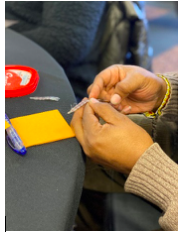Indigenous - Native American, Urban
Bead-work and the Ministry of Presence

As I walked through the doors of the Native Friendship Center and mounted the stairs to the loft, I heard the cheerful laughter that told me my friend was there. No one laughs like Marie*.
When I rounded the corner I was greeted with a hearty “Hey!” While I sat down and pulled my beads and thread out of my bag, Marie showed me her latest creations: a beaded medallion in the style that I showed her a month before, a pair of earrings that matched the medallion, and a bracelet from her Navajo friend.
Her eyes beamed with pride as she explained her color choices and showed me pictures from her recent travels. After figuring out a new pattern and discussing whether to tie a knot or melt the thread ends we settled down to working our respective projects.
After a few moments Marie looked up and said to me that her adult son was coming to visit unexpectedly. I looked up intently and asked her to tell me more as this was the first time she had ever mentioned her family. While choosing beads from the dish she began to recount the painful story of her ex-husband, her extended family, and the emotional and physical toll that it took on her.
In my head I was amazed at how open and honest she was being with me as she gifted me her story. Her normal and distinct laughter was replaced by pain and sadness. When she had finished telling her story, I gave her a few words of encouragement, and lifted a silent prayer to Creator on her behalf. Then we continued beading.
My interaction with Marie that day is a beautiful example of what my ministry among the Indigenous people of Montreal looks like. Creation, in this case beadwork, serves as a medium for relational development and a place of healing.
Sean Everett Gantt, in his thesis Nanta Hosh Chahta Immi, What are Choctaw Lifeways**, stated that for my people, the Choctaw, traditional sash beadwork consisted of three elements: the beads whose colors represent different cultural activities, the patterns representing tradition, and the thread holding it all together which is community.
As I sat with Marie, I was weaving the thread of community that allowed for her to feel safe enough to share her story. By speaking about her pain she was able to achieve some modicum of healing as I shouldered a piece of her burden by listening. In a sense, she was adding new beads of storytelling, partnership, caring, and perseverance to our thread of community. Our weekly gathering at the beading circle, our inside jokes, our beginning projects for newcomers, our sharing of our completed pieces add to the pattern of our traditional beaded sash.
So often people ask me what I do in ministry. I can give a rote list of the various pieces of work that I do. The truth, however, is that I don’t really do it. I simply be. By sitting with Marie, she was free to unburden her soul. By stringing beads on thread, she felt free to press in to her healing. God gave my Choctaw ancestors this tradition and as I have practiced it, ministry is the created peace that flows from it. I don’t have to do anything. There isn’t an intricate strategic plan or a twelve point budget. I simply sit and be with my aunt, Marie.
What a blessing the ministry of presence is! How powerful is this gift that my ancestors received from our Creator. As we seek to help our brothers and sisters heal, growing closer to God, we can stand to learn more from the traditional gifts that he has given us in the past.
*Names have been changed to protect identities.
**Source: Gantt, Sean Everett. "Nanta Hosh Chahta Immi? (What Are Choctaw Lifeways?): Cultural Preservation in the Casino Era." University of New Mexico (2013).

Connect to The Network and add your own question, blog, resource, or job.
Add Your Post
Let's Discuss
We love your comments! Thank you for helping us uphold the Community Guidelines to make this an encouraging and respectful community for everyone.